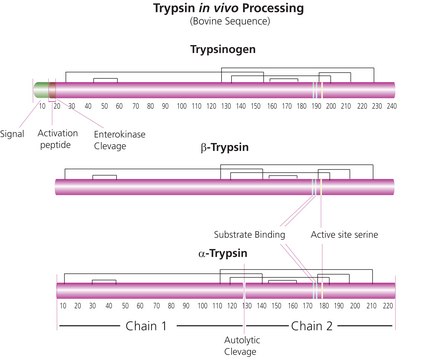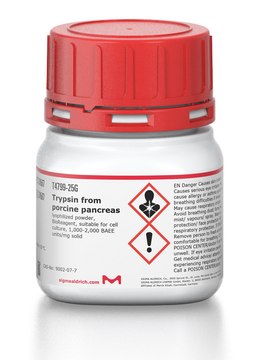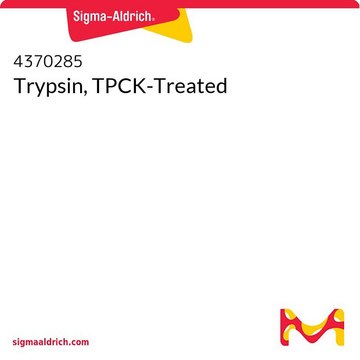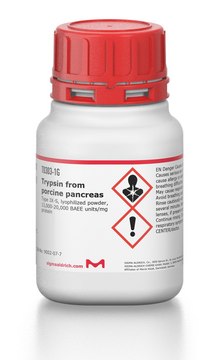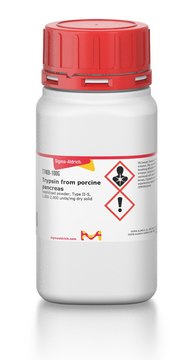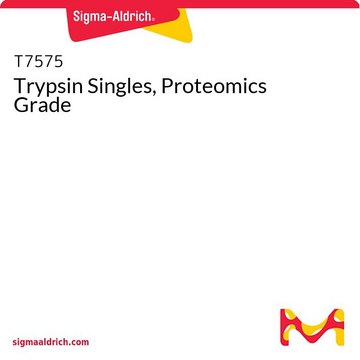T8802
Trypsin from bovine pancreas
TPCK Treated, essentially salt-free, lyophilized powder, ≥10,000 BAEE units/mg protein
Sign Into View Organizational & Contract Pricing
All Photos(1)
About This Item
Recommended Products
biological source
bovine pancreas
Quality Level
sterility
aseptically filled
form
essentially salt-free, lyophilized powder
specific activity
≥10,000 BAEE units/mg protein
mol wt
23.8 kDa
composition
protein, ≥95%
solubility
hydrochloric acid: soluble 1 mM, clear
foreign activity
Chymotrypsin ≤0.1 BTEE units/mg protein
storage temp.
−20°C
Looking for similar products? Visit Product Comparison Guide
Related Categories
General description
The trypsin molecule has two domains: one is related to the enzyme active site and the tryptophan residues; the other is related to the 8-anilinonaphthalene-1-sulfonate binding.
Application
For trypsin digestion of peptides, use a ratio of about 1:100 to 1:20 for trypsin:peptide. The typical use for this product is in removing adherent cells from a culture surface. The concentration of trypsin necessary to dislodge cells from their substrate is dependent primarily on the cell type and the age of the culture. Trypsins have also been used for the re-suspension of cells during cell culture, in proteomics research for digestion of proteins and in various in-gel digestions. Additional applications include assessing crystallization by membrane-based techniques and in a study to determine that protein folding rates and yields can be limited by the presence of kinetic traps.
Trypsin can be used to release adherent cells from tissue culture plates for passaging. Trypsin has been used in a study to assess the effects of macromolecular crowding on the structural stability of human α-lactalbumin. Trypsin has also been used in a study to investigate BN-PAGE analysis of Trichoderma harzianum secretome.
Biochem/physiol Actions
Trypsin cleaves peptides on the C-terminal side of lysine and arginine residues. The rate of hydrolysis of this reaction is slowed if an acidic residue is on either side of the cleavage site and hydrolysis is stopped if a proline residue is on the carboxyl side of the cleavage site. The optimal pH for trypsin activity is 7-9. Trypsin can also act to cleave ester and amide linkages of synthetic derivatives of amino acids. EDTA is added to trypsin solutions as a chelating agent that neutralizes calcium and magnesium ions that obscure the peptide bonds on which trypsin acts. Removing these ions increases the enzymatic activity.
Serine protease inhibitors, including DFP, TLCK, APMSF, AEBSEF, and aprotinin, amongst others, will inhibit Trypsin.
Serine protease inhibitors, including DFP, TLCK, APMSF, AEBSEF, and aprotinin, amongst others, will inhibit Trypsin.
Unit Definition
One BAEE unit will produce a ΔA253 of 0.001 per min at pH 7.6 at 25 °C using BAEE as substrate. Reaction volume = 3.2 ml (1 cm light path).
One BAEE unit will produce a A253 of 0.001 per minute at pH 7.6 at 25°C using BAEE as a substrate.
Preparation Note
TPCK treated
Analysis Note
Protein determined by E1%/280
Other Notes
View more information on trypsin at www.sigma-aldrich.com/enzymeexplorer
inhibitor
Product No.
Description
Pricing
substrate
Product No.
Description
Pricing
signalword
Danger
hcodes
Hazard Classifications
Eye Irrit. 2 - Resp. Sens. 1 - Skin Irrit. 2 - STOT SE 3
target_organs
Respiratory system
Storage Class
11 - Combustible Solids
wgk_germany
WGK 1
ppe
dust mask type N95 (US), Eyeshields, Faceshields, Gloves
Choose from one of the most recent versions:
Already Own This Product?
Find documentation for the products that you have recently purchased in the Document Library.
Customers Also Viewed
Our team of scientists has experience in all areas of research including Life Science, Material Science, Chemical Synthesis, Chromatography, Analytical and many others.
Contact Technical Service